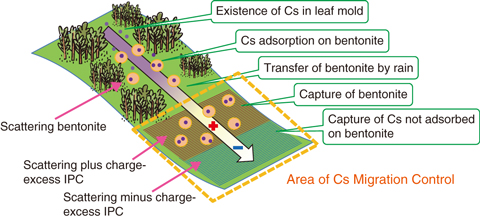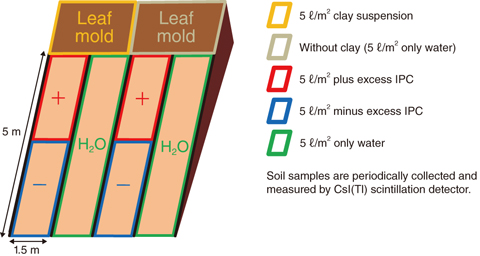
Fig.1-35 Scheme for suppression of Cs migration

Fig.1-36 Verification-testing procedure in Iitate-mura, Fukushima

Fig.1-37 (a) Distribution of radioactive Cs on the slope after three months and (b) Appearance of soil-core sampling on the slope
Much of the radioactive cesium (Cs) in forests exists in leaf mold (a form of compost produced by biodegradation) between litter and soil layers. Some plants can take up the radioactive Cs existing in the leaf mold when it is released from organic substances owing to their decomposition and dissolved into soil water. In addition, on a sloped ground, the Cs is transferred to a lower zone; thus, there is the potential that living areas already decontaminated may be polluted again.
A new technology to suppress Cs migration from forests has been developed collaboratively by Ibaraki University, Kumagai gumi Co., Ltd. and its group of company, and the Japan Atomic Energy Agency. The new technology using polyelectrolytes (which are polymers with electric charges and clay minerals) to control Cs migration with the aid of natural forces such as rainfall and rainwater runoff; the polyelectrolytes are utilized as food additives etc. and clay minerals are utilized as ordinary natural products; both are non-hazardous. The new technology is expected to mildly regenerate village forests (i.e., forests near human dwellings) without destroying their ecosystems. In Iitate-mura, Fukushima, verification tests of the new technology have been performed and its effect on controlling Cs migration in sloped areas of the forests has been proven.
By scattering bentonite (the generic name of clay having montmorillonite as a main component) particles that strongly adsorb radioactive Cs existing in leaf mold, Cs can be expected to be changed from the dissolved form that is easily taken up by plants into the fixated form, which is difficult for plants to absorb; the Cs bound to organic substances, which is easily released and dissolved into soil water, is changed into Cs that is immobilized in clays and almost insoluble in water. In contrast, the bentonite particles adsorbing radioactive Cs are transferred to a lower zone as mud water by being mixed with rainwater; then, these particles can be captured by electric-charge-controlled IPCs. The IPCs formed by mixing two polyelectrolytes having charges opposite to each other are highly viscous gels and can thus catch bentonite particles together with soil particles using their strong viscosity. Plus-charge-excessive IPCs, in which the number of cationic polyelectrolytes is larger than that of anionic polyelectrolytes, can capture bentonite particles with negatively charged surfaces more effectively than can non-charged IPC. Moreover, by arranging minus-charge-excessive IPC below the plus-charge-excessive-IPC zone in a sloped area, positively charged radioactive Cs unfixed by bentonite particles can also be caught, ensuring definitive Cs-migration control (Fig.1-35). By scattering both bentonite and IPCs over a slope area, a larger amount of radioactive Cs remains on an upper position and Cs migration is reduced to less than one-fifth its original concentration (Figs.1-36 and 1-37).
The present study is a fruit developed by applying a patent method in the reference below and press-released by the Ibaraki University, the Kumagai Gumi Co., Ltd., and the JAEA, on May 10, 2016.